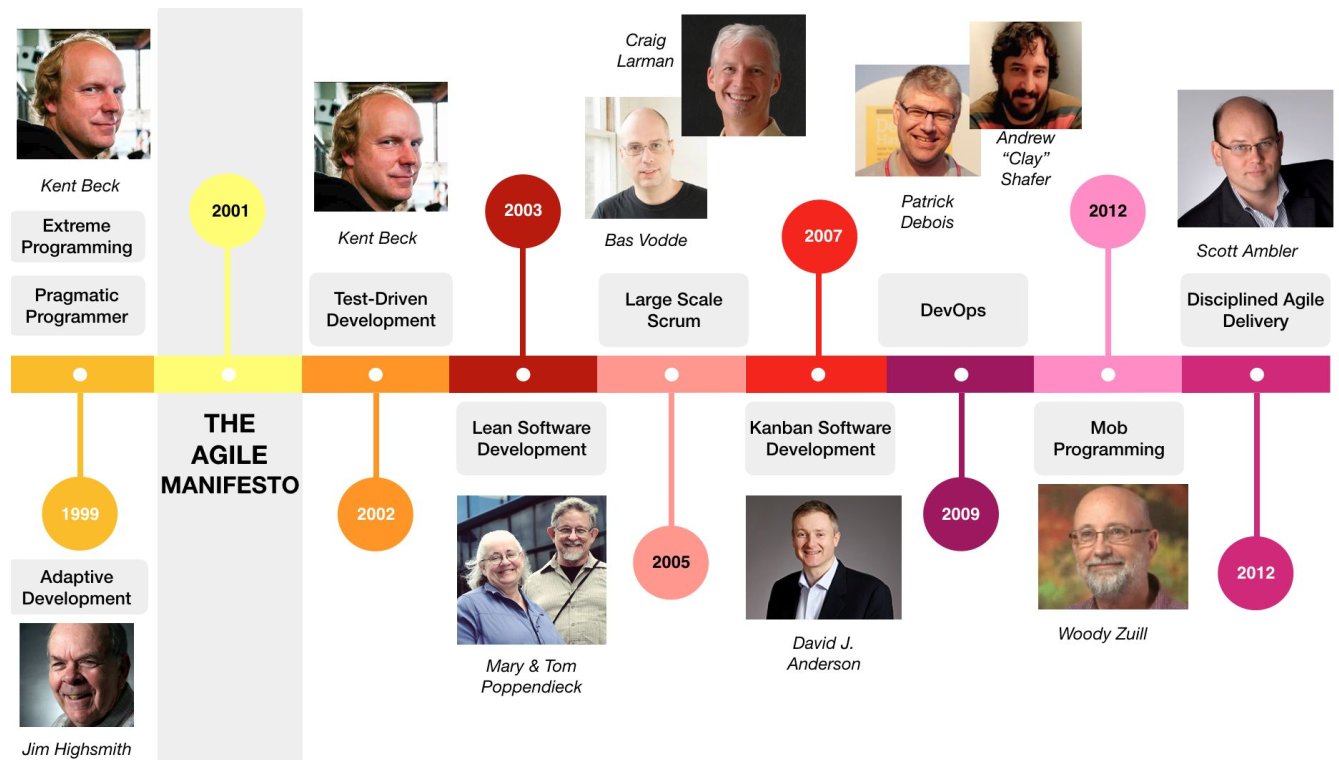
- Software Development
In February 2001, in the Wasatch Mountains (Utah – USA), seventeen consultants got together to discuss working methods in the technology area, aiming to find common ground for software development. This Conference gave rise to the Agile Manifesto, a movement that transformed IT and still guides the way in which digital products and services are created.
Our Agilist, Raphael Rodrigues, took advantage of SoftDrops* to tell this story, highlight the principles of the Manifesto and explore the characteristics of the Agile Method. Below, we share the most important moments of his presentation.
Among the consultants present at the February 2001 Conference, Raphael highlighted: Kent Beck, Rod Jeffries and Ward Cunningham, creators of the Extreme Programming (XP); Ken Schwaber and Jeff Sutherland, creators of Scrum; Alistair CockBurn, creator of Crystal Clear; Martin Fowler, author of leading books on design patterns and the UML; and Robert C. Martin, author of fundamental books on programming and clean code.
However, it should be noted that before the meeting, the topic of process improvements was already under discussion in the product area. Some of the Agile Methods mentioned in the previous paragraph took their first steps even before the Conference.
But it is worth mentioning that in 1945, William Edwards Deming revolutionized production processes in Japan and the United States by proposing the application of statistical methods (influencer of the Toyota Production System); and Hirotaka Takeuchi and Ikujiru Nonaka, who in 1986 created the New Product Development Game approach, streamlining and making product development more flexible (at companies such as Canon, IBM, 3M, among others).

With all these initiatives happening over time, what was then the motivation for the February 2001 Conference? The consultants involved were looking for a common model, an alternative to software development processes that, structured in the Waterfall Method (created within the Engineering area), were considered cumbersome and too documentation-oriented.
This meeting gave life to the Agile Alliance, which still dictates and contributes to the organization of processes in the area; and originated the Manifesto for Agile Software Development, with its mindset, values and principles. Such values provide guidance on how to create and respond to change, and on how to deal with uncertainty:
“This work method is based on empiricism. So, what we do today is a scientific method in which we don’t know the truth, we don’t know what will emerge during the process. Before (in Waterfall), what we did was plan and stick to the plan, documenting the steps as scheduled. With the Agile Method, we assume hypotheses, carry out experiments and tests to validate them, which generates learning”, explained Raphael.
The Conference impacted the following years and boosted the emergence of several work models such as Test-Driven Development (TDD); Lean Software Development, Large Scale Scrum (LeSS), Kanban Software Development, DevOps, Mob Programming and Disciplined Agile Delivery (DAD), among many others.

There are four core values of the Agile Manifesto, which began to be valued after February 2001 in software development practices:
Raphael explained that it is necessary to understand that it does not mean that the items on the right are not important and should not be carried out, but rather that in this mentality adaptation, they are inferior to the items on the left, which must be prioritized. Such values summarize the 12 Agile Principles that can be seen in the image below – the first four are aimed at customers; the next four to management, and the final four to the team:

Agility is a big umbrella that encompasses several practices, from lighter processes for small teams, to more robust processes for larger teams. We can mention Scrum, Kanban, XP, TDD and Crystal as lightweight approaches, and LeSS, DAD, Agile Project Management (Agile PM) and Open Unified Process (OpenUP) as heavier approaches, for example.
For Raphael, Agile Methods are conventions that teams choose to follow. “If the team is working according to agile principles, they are trying to be agile. What matters is not the framework (Scrum, Kanban, etc.), but the agreements that are made within the team. The framework brings a condensation of ideas that worked, but it needs to be adapted to the context and reality of each team”.
In this regard, it is important to point out that it is possible to use several practices in the same project. It is not essential to follow only one framework from start to finish, but to use practices that generate the best results in that case. In fact, in the image below, we can see how the different practices of frameworks can interact.

Even with many changes in the world, by observing the agilist it is possible to see a growing movement of agile practices in contexts outside of software development or product creation, where there is greater integration with design practices. And, also, in areas such as Marketing and HR – the latter even has its own manifesto.
For Raphael, the future of what we call agility is more related to best practices in management, leadership and organizational culture, focusing on collaboration and people development – being pragmatic in terms of frameworks or methods. Thus, we guarantee that the creation of products will be focused on customers, and on the end-to-end value stream.

